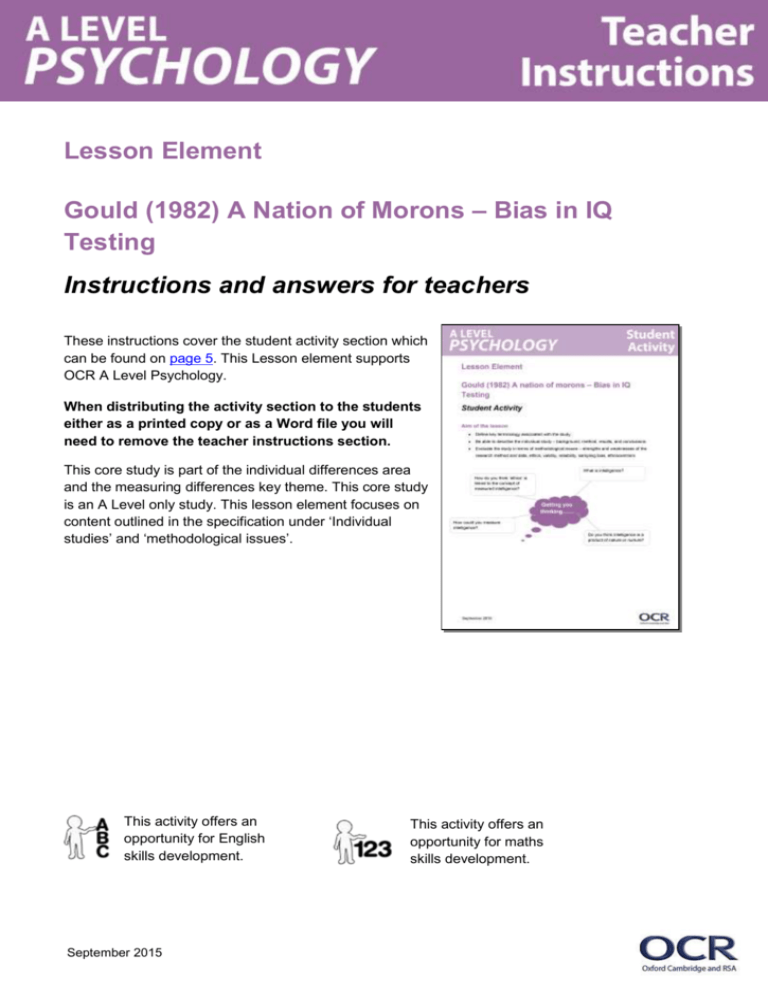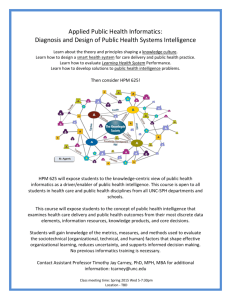A Level Psychology Lesson Element (Gould (1982) A Nation
advertisement

Lesson Element Gould (1982) A Nation of Morons – Bias in IQ Testing Instructions and answers for teachers These instructions cover the student activity section which can be found on page 5. This Lesson element supports OCR A Level Psychology. When distributing the activity section to the students either as a printed copy or as a Word file you will need to remove the teacher instructions section. This core study is part of the individual differences area and the measuring differences key theme. This core study is an A Level only study. This lesson element focuses on content outlined in the specification under ‘Individual studies’ and ‘methodological issues’. This activity offers an opportunity for English skills development. September 2015 This activity offers an opportunity for maths skills development. Introduction to the task The aim of this lesson element is for students to be able to describe the review of Yerke’s research, and how Yerke’s research was carried out. Students should also be able to evaluate the study. Summary and Background Gould examined the work of an influential psychologist, Robert Yerkes, who had conducted the largest intelligence testing in history. Gould reviewed Yerkes’ methodology and also the implications of his research, which contributed to the Eugenics movement, causing legal restrictions on immigration to America for certain groups and preventing approximately six million Europeans from escaping persecution and seeking refuge between 1924 and 1939. Yerkes had conducted mass intelligence testing using psychometric tests with 1.75 million US army recruits. Participants took one of three tests, and Yerkes found that there were significant differences in mental ages, with White Americans having the highest score, and Black Americans, having the lowest mental age score. Gould reviewed his work, and found systematic errors in the content and design of his work. He also concluded that intelligence testing of this kind is highly susceptible to bias and leads to racial discrimination. September 2015 Student misconceptions Students can struggle with the notion of a review article, and may confuse Gould with Yerkes in terms of who designed and administered the intelligence tests. It’s important to emphasis the concept of a ‘review.’ Students may also question what a ‘psychometric test’ is, and therefore a good idea would be to share an example of Yerke’s Army Alpha test, and highlight how it generates quantitative data. Teacher Preparation Students should be given an introduction to the topic, by considering the key questions at the start of the lesson. This can then be discussed and linked to a brief overview of Gould’s review. Students should then be introduced to the key terminology. A good idea is for definitions to be scattered around the classroom, and for students to try to match and complete the table. You will need access to an OCR text book and/or OCR’s Guide to Core Studies 2 (pages 50-56) to develop the correct definitions. Students can then work in pairs/small groups to complete the tables on the study; procedure, results and evaluation. The type of answers required have been modelled. Students should take responsibility for conducting research of a key area e.g. one on method, another on results, or evaluation. Once they have completed their research task, they should teach the other member of their group on their designated aspect of the study Possible student questions What is a review article? A review article summarises and critiques research previously conducted. What is IQ? IQ stands for ‘Intelligence quotient.’ IQ is simply a measurement of certain abilities - there is no pass or fail in an IQ test. Just as there are different types of intelligence, so there are different types of test to measure them. Why did Gould review Yerkes’ work? In order to highlight the problems with mass intelligence testing such as the biases within Yerkes’ research and the ethical implications of reporting on intelligence and its use and impact on society. How was the study by Yerkes unethical? Yerkes’ research led to racial biases within US immigration law, US military rankings, and arguably in the way America viewed people from different parts of the world. His research has serious ethical costs i.e. prevented Europeans seeking refuge during WWII. Is there a better way to measure intelligence? September 2015 Devise tests that do not rely on cultural knowledge in order to score highly. Also tests should take account of different language abilities for people of different nationalities. .It would also be more benefit to sit a series of different types of tests rather than just one. What is an example of a question from the Army Alpha test? Crisco is a: patient, medicine, disinfectant, food product The number of a Kaffir’s legs is: 2, 4, 6, 8 Christy Mathewson is famous as a: writer, artist, baseball player, comedian. Students will need a copy of all sheets provided in the lesson element. The teacher will need a text book, Guide to core studies 2, their own notes on the study and evaluation in order to support students on completion of the tasks. We’d like to know your view on the resources we produce. By clicking on ‘Like’ or ‘Dislike’ you can help us to ensure that our resources work for you. When the email template pops up please add additional comments if you wish and then just click ‘Send’. Thank you. If you do not currently offer this OCR qualification but would like to do so, please complete the Expression of Interest Form which can be found here: www.ocr.org.uk/expression-of-interest OCR Resources: the small print OCR’s resources are provided to support the teaching of OCR specifications, but in no way constitute an endorsed teaching method that is required by the Board, and the decision to use them lies with the individual teacher. Whilst every effort is made to ensure the accuracy of the content, OCR cannot be held responsible for any errors or omissions within these resources. © OCR 2015 - This resource may be freely copied and distributed, as long as the OCR logo and this message remain intact and OCR is acknowledged as the originator of this work. OCR acknowledges the use of the following content: Maths icon: Air0ne/Shutterstock.com Please get in touch if you want to discuss the accessibility of resources we offer to support delivery of our qualifications: resources.feedback@ocr.org.uk September 2015 Lesson Element Gould (1982) A nation of morons – Bias in IQ Testing Student Activity Aim of the lesson Define key terminology associated with the study. Be able to describe the individual study – background, method, results, and conclusions. Evaluate the study in terms of methodological issues – strengths and weaknesses of the research method and data, ethics, validity, reliability, sampling bias, ethnocentrism. What is intelligence? How do you think ‘ethics’ is linked to the concept of measured intelligence? Getting you thinking…… How could you measure intelligence? Do you think intelligence is a product of nature or nurture? September 2015 Key word Definition Hereditarian position Eugenics Psychometric testing IQ Army Alpha Army Beta Background to the study What did Binet believe about intelligence? What do hereditarians believe about intelligence? September 2015 Complete the following table in fine detail Aim The aim was to reveal basic problems in attempts to measure intelligence, specifically in the research carried out by Robert Yerkes’ in 1921. The aim of Yerkes’ study was to devise a scientific way to test the natural trait of intelligence on a mass scale. Research Method Gould reviews and critiques Yerkes’ methodology: psychometric testing of intelligence Participants Design and Procedure Three types of tests: Army Alpha: Army Beta: Individual Examinations: Issues with the tests Test conditions: Reliance on cultural knowledge: Inconsistencies within the procedure: September 2015 Results Table of findings: Group White American Black American Russian immigrant Italian immigrant Polish immigrant Mean mental age 13.04 10.41 11.34 11.01 10.74 Previous research had set the average mental age of white Americans to be age 16, therefore age 13 was thought to be on the edge of moronity. His findings show that the average man of many nations would be classed as a ‘moron.’ Notably, differences were matched with fairness of skin. These findings influenced the assignment of different military ranks. Conclusions September 2015 Evaluating the study What key issues require evaluation? Evaluation… Point/Theme Psychometric testing Quantitative data September 2015 Explain (How/why is it a strength/ weakness? Use key terminology) An advantage is that they are standardised, objective and therefore scientific measurements of psychological concepts such as IQ. Example (give a specific example from the study…) The test was received in the same way by each participant, and generated quantitative data which can be analysed objectively. However, psychometric tests offer a reductionist measure of intelligence. Assume that intelligence is fixed and unchanging over time, which is over simplistic, and therefore does not give a full measure of intelligence. A strength of quantitative data is that it is objective and easy to analyse, i.e. provide direct comparisons and allows us to establish a ‘group norm.’ The scores on each test were counted, and mean mental ages for each group calculated-as its numerical this is objective. A weakness however, is that it is reductionist, it implies there is a difference, but does not give any insight into why the differences exist. For example, the mean mental age was 13 for white Americans, and 10 for black Americans- we do not have any information on why this difference exists, which limits the usefulness of the research. Point/Theme Ethics Validity Reliability Sample September 2015 Explain (How/why is it a strength/ weakness? Use key terminology) Example (give a specific example from the study…) Point/Theme Practical applications September 2015 Explain (How/why is it a strength/ weakness? Use key terminology) Example (give a specific example from the study…) Gould’s review of Yerkes’ study is useful as it highlights the dangers and precautions that should be taken regarding mass intelligence testing. Yerkes had a profound negative impact on social policy, therefore such a biased approach that ignores cultural differences must be avoided. Although flawed in his methodology, Yerkes’ attempt to make intelligence testing scientific has made a significant contribution to how we measure intelligence today For example, many of the mental tests in the Army Alpha were revised and marketed for use in education.






